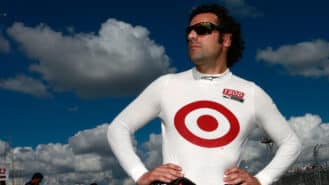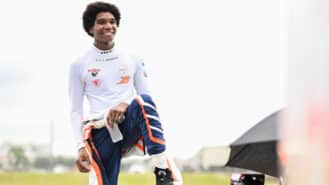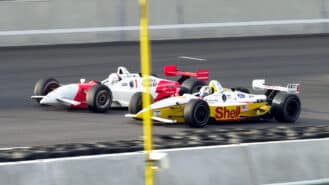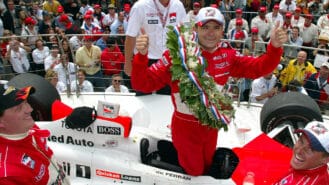A series taken from the 164-page Motor Sport special Great Racing Cars, which is available to buy here

From the editor Damien Smith
How would you define a ‘great’ racing car? Race wins and championship titles are an obvious place to start – and admittedly, when we began the process of rounding up the ‘voices’ to fill this special magazine, published by the team behind Motor Sport, we had in mind the likes of the Lotus 72, Ferrari F2004, Porsche 917, Audi R10 and so on.
But as the interviews of familiar racing figures began, we realised greatness is often a very personal thing. Naturally, most – but not all – would pick cars they had experienced first-hand, as a driver, designer, engineer or team boss. And on occasion the cars that stood out in their minds as ‘great’ weren’t necessarily so in the grand scheme of history. That’s why you’ll find a Minardi here among Formula 1 cars from Lotus, Williams and McLaren.
Unexpected? Certainly. Wrong? Not to the man who chose it.
As the interviews accumulated, our magazine took on a life of its own, full of personal anecdotes about the myriad cars that made careers. Some of those we spoke to, such as Mario Andretti and Dan Gurney, couldn’t be tied to a single choice from multi-faceted lives at the wheel. Such heroes have earned the right to choose an F1, sports and Indycar, so we allowed them more than one bite.
Others refused to be confined by category. Hence the short ‘Odd ’n Sods’ chapter on cars that, by and large, are mere footnotes in lower divisions of racing lore.
Thus there is nothing definitive about the selection listed herein. Then again, there’s no claim that this compilation offers the ‘Greatest Racing Cars’ of history. It’s much more personal than that, much more quirky – and all the better for it.

Bobby Rahal
Three-time Indycar champion, 1986 Indy 500 winner

I think my favourite car that I raced was probably my ’92 Lola. I won on three of the mile tracks and should’ve won Milwaukee where I was on pole, led the race and got caught out by a yellow. We were quick everywhere in that car on short ovals, big ovals, road courses and street circuits, and we won the championship.
When you have a car that’s good on the ovals those tracks can be so much fun to drive. That year I led every lap at Phoenix and Michael [Andretti] and I had a good tussle at New Hampshire, but I lapped him during that race and was the only guy on the lead lap.
It was just one of those years where we were totally in sync with the car. It was a year whenever you went to a track you were really looking forward to it because you knew you were going to be right there every time you were on the track. We had a great understanding of that car and a great set-up. It all worked everywhere we went. It was very cool.
From the Motor Sport archive: an excerpt from Lunch with Bobby Rahal (April 2015).
“We switched to Lola for 1987, and we won the championship again. Indy ’86 should be the race I’m most proud of, but actually it’s Meadowlands ’87. I hated Meadowlands, a contrived little track squeezed into a parking lot, but for some reason you win at the tracks you hate. I won there three years, and whenever I beat Andretti that felt good because I always considered Mario the yardstick. I thought the world of him, still do. I won Laguna Seca four years in a row, but Elkhart Lake, a track I loved, I only won there twice.
“Truesports wasn’t the same without Jim, and eventually I had to take the decision to move on. I went to Kraco, and was runner-up in the championship in ’91, but I’d got to the point where I wanted to do my own thing. Racing was my life, I’d have to retire one day, and I wanted to stay involved. Being a team owner fitted in with that. At first I went into 50/50 partnership with Carl Hogan. Rahal/Hogan’s first race was Phoenix, and I led every lap. Then we won three of the four mile ovals, and I ended up with my third championship title. But Carl and I didn’t agree about everything. So I bought him out, and David Letterman came in as a minority shareholder. He hosts the world’s longest-running late-night TV show, but he’s also a massive enthusiast.”
In 1994 Bobby brought Honda into CART as an engine manufacturer, although the partnership only lasted one racing year. Then, using the Ilmor-Mercedes engine, he finished a strong third in the 1995 championship. “At 45 I realised it was time to retire as a driver. You have to be honest with yourself. My goal was to be competitive right up to when I hung up my helmet, and racing against guys 20 years younger than me I did get on the podium in my last season, 1998. At my final race, Fontana, my entire team put on Groucho Marx masks: big nose, bald head, glasses. I can’t think who they were all pretending to be.”

The battle between CART and the IRL was painful – at one stage Bobby became interim president and CEO of CART to try to help solve its problems – but in 2004 he bowed to the inevitable and switched his team to IRL. And that year he became an Indy 500 winner again, this time as a team owner, when Buddy Rice scored Honda’s first Indianapolis victory.
To read the rest of this article click here.







